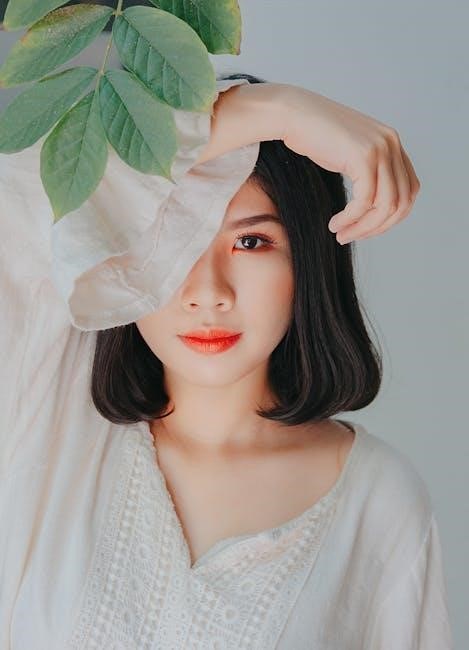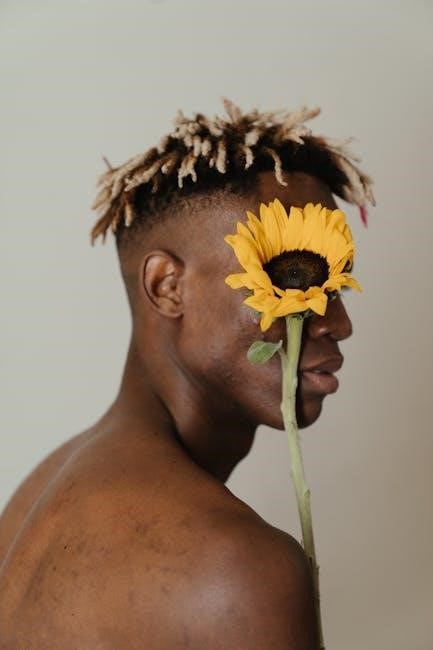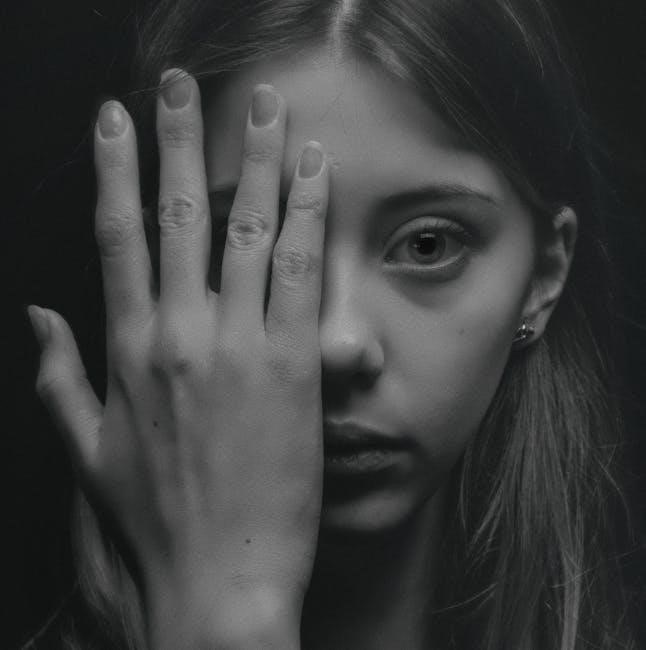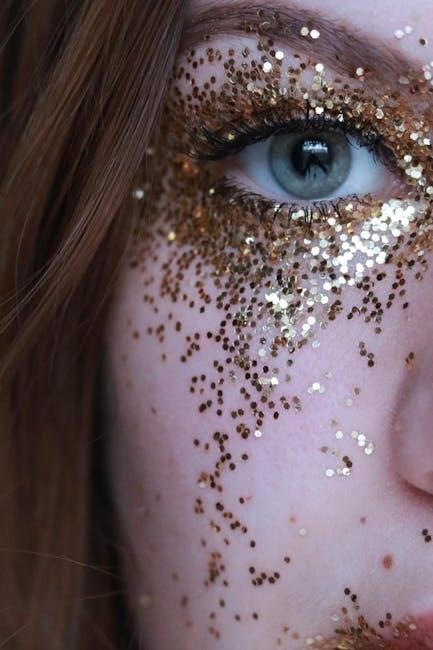Toni Morrison’s debut novel, The Bluest Eye, explores themes of beauty, race, and self-worth through the story of Pecola Breedlove, a young Black girl in 1940s Ohio.
Overview of the Novel
The Bluest Eye, Toni Morrison’s debut novel, published in 1970, is a poignant exploration of racial identity, beauty standards, and self-worth. Set in Lorain, Ohio, during the 1940s, the story revolves around Pecola Breedlove, a young Black girl who yearns for blue eyes, believing they will bring her acceptance and love. Through her tragic journey, Morrison examines the destructive impact of internalized racism and societal beauty ideals. The novel is narrated by Claudia MacTeer, offering a dual perspective on the events that unfold.
Historical Context and Background
The Bluest Eye is set in Lorain, Ohio, during the 1940s, a time marked by racial segregation and discrimination. Morrison draws from her own experiences growing up in Lorain, reflecting the societal norms that devalued Blackness. The novel critiques the internalized racism stemming from historical oppression and the beauty standards perpetuated by a predominantly white culture. The post-World War II era’s rigid social hierarchies and the Great Migration’s impact on African American communities further shape the story’s backdrop, highlighting the systemic racism faced by characters like Pecola Breedlove.
Significance of the Title
The title, The Bluest Eye, reflects Pecola Breedlove’s longing for blue eyes, symbolizing her internalized racism and desire to conform to white beauty standards. This wish represents the broader societal issue of racial self-hatred and the destructive pursuit of unattainable beauty ideals. The blue eyes embody a false promise of acceptance and love, highlighting the devastating impact of racism on self-esteem and identity. Morrison uses this title to critique the notion that whiteness is the ultimate measure of beauty and worth.
Major Themes in “The Bluest Eye”
Toni Morrison explores themes of beauty, race, and self-worth in The Bluest Eye, highlighting societal oppression and its impact on Black identity and internalized racism.
The Theme of Beauty and Racism
Toni Morrison’s The Bluest Eye delves into the destructive intersection of beauty standards and racism; Pecola Breedlove’s desire for blue eyes reflects societal ideals that devalue Black features, perpetuating internalized racism and self-hatred. Morrison critiques how White beauty is idolized, marginalizing Black identity. This theme is central to the novel, exploring how external beauty norms erode self-esteem and perpetuate racial oppression, leaving lasting emotional scars on individuals and communities. The novel underscores the devastating impact of these ideals on Black girls’ self-perception.
The Impact of Internalized Racism
In The Bluest Eye, internalized racism profoundly damages the characters’ sense of self-worth. Pecola Breedlove’s longing for blue eyes symbolizes her acceptance of White beauty standards, which devalue her Black identity. This internalization leads to self-loathing and a fragmented sense of self. Morrison illustrates how societal racism infiltrates the minds of Black individuals, causing them to see themselves as inferior. This psychological damage perpetuates cycles of self-hatred and despair, highlighting the destructive legacy of racial oppression and its impact on individual and communal identity. The novel underscores the deep scars left by such internalized beliefs.
The Destruction of Self-Esteem
The novel vividly portrays how societal beauty standards and racial prejudice erode self-esteem. Pecola Breedlove’s desire for blue eyes reflects her internalized belief that Whiteness is the ultimate beauty ideal. Repeatedly rejected by her family and community, Pecola’s self-worth disintegrates, leading to psychological collapse. Morrison highlights how external biases infiltrate the minds of marginalized individuals, fostering self-loathing and a distorted self-image. This destruction of self-esteem underscores the profound emotional toll of racism and its enduring impact on personal identity and mental health. The novel serves as a powerful critique of these societal harms.

Key Characters in the Novel
The novel centers around Pecola Breedlove, the tragic heroine, Claudia MacTeer, the narrative voice, and Frieda, her sister, along with other significant characters like Cholly and Pauline Breedlove.
Pecola Breedlove: The Tragic Heroine
Pecola Breedlove is the central figure of The Bluest Eye, a young African American girl living in Lorain, Ohio, during the 1940s. She is deeply affected by the societal beauty standards that devalue Black features, leading her to yearn for blue eyes. This desire stems from her internalized racism and a belief that such eyes would bring her love and acceptance. Pecola’s tragic fate is shaped by her family’s dysfunction, poverty, and the oppressive racial environment, making her a symbol of the devastating impact of self-hatred and societal rejection.
Claudia MacTeer: The Narrative Voice
Claudia MacTeer serves as the narrative voice of The Bluest Eye, offering a reflective perspective on the story of Pecola Breedlove. As a young African American girl from a more stable and loving family, Claudia contrasts sharply with Pecola’s tragic experiences. Her narration bridges the past and present, providing context and insight into the events. Claudia’s voice is both innocent and wise, allowing readers to grasp the deeper societal issues while witnessing her growth and understanding of the world around her.
Other Major Characters and Their Roles
Cholly Breedlove, Pecola’s father, is a complex figure whose traumatic past shapes his abusive behavior. Sula, Claudia’s sister, represents youthful rebellion and curiosity. Mrs. MacTeer embodies maternal warmth and strength, contrasting with the Breedloves’ dysfunction. Mr. MacTeer, Claudia’s father, symbolizes stability and quiet resilience. These characters collectively highlight the societal and familial challenges faced by African Americans, enriching the novel’s exploration of identity, race, and human frailty.

Symbolism in “The Bluest Eye”
The novel uses powerful symbols like blue eyes and dandelions to explore themes of beauty, race, and destruction. Blue eyes represent societal beauty standards and internalized racism, while dandelions symbolize disruption and the shattering of innocence, reflecting Pecola’s tragic journey.
The Symbol of Blue Eyes
The blue eyes Pecola longs for symbolize societal beauty standards and internalized racism. They represent her desire to fit into a world that devalues Black features, highlighting the destructive nature of Eurocentric ideals. Morrison uses this symbol to critique how external beauty norms distort self-perception, leading to self-hatred and alienation. The unattainable blue eyes embody Pecola’s tragic quest for acceptance, reflecting broader themes of racial oppression and the shattered self-esteem of Black individuals in a white-dominated society.
The Dandelions as a Symbol of Disruption
Dandelions in The Bluest Eye symbolize disruption and the unsettling of order. Often viewed as weeds, they represent the unwanted presence of characters like Pecola, who disrupt societal norms. Their resilience mirrors the enduring strength of marginalized communities despite oppression. Morrison uses dandelions to illustrate how beauty can coexist with ugliness, challenging traditional notions of worth. This symbolism underscores the novel’s exploration of how societal structures marginalize certain groups, leaving them to thrive in unexpected ways despite adversity and neglect.
Study Guide Elements

A comprehensive study guide for The Bluest Eye includes plot summaries, character analyses, discussion questions, and an exploration of literary devices to deepen understanding of the novel.
Plot Summary and Chapter Analysis
The Bluest Eye follows Pecola Breedlove, a young Black girl in 1940s Lorain, Ohio, who yearns for blue eyes, believing they will bring her acceptance and love. The novel unfolds through multiple perspectives, including Claudia MacTeer’s narrative, offering insights into Pecola’s tragic journey. Each chapter examines themes of beauty, race, and internalized racism, while the analysis reveals how societal beauty standards and communal complicity destroy Pecola’s self-esteem. The story exposes the devastating impact of racial oppression on Black identity and self-worth.
Analysis of Literary Devices
Toni Morrison employs vivid symbolism, with blue eyes representing societal beauty standards and internalized racism. Imagery highlights Pecola’s fragmented identity, while allusions to cultural norms underscore the novel’s critique of racial oppression. Morrison uses non-linear narration and multiple perspectives to reveal the complexities of Pecola’s experience. Her lyrical prose and poetic language enhance the emotional depth, making the novel a powerful exploration of self-worth and racial identity. These devices collectively create a haunting narrative that lingers long after the story ends.
Discussion Questions and Essay Topics
- How does Pecola’s desire for blue eyes reflect societal beauty standards and internalized racism?
- Analyze Claudia’s narrative voice and its role in conveying the novel’s themes.
- What impact does the community’s rejection have on the Breedlove family’s self-esteem?
- Discuss Morrison’s use of symbolism, particularly the dandelions and blue eyes.
- How does the novel critique the notion of beauty and its relation to racial identity?
These questions encourage exploration of the novel’s deeper themes and literary elements, fostering critical analysis and understanding.

Author Biography and Legacy
Toni Morrison, born Chloe Wofford in 1931, was a Nobel and Pulitzer Prize-winning novelist, essayist, and professor. Her works explore race, identity, and history, leaving a profound literary legacy.
Toni Morrison’s Background and Writing Style
Toni Morrison, born in Lorain, Ohio, in 1931, grew up in a family that cherished storytelling, influencing her rich narrative style. She began writing The Bluest Eye while teaching at Howard University, blending lyrical prose with sharp social critique. Morrison’s work often explores the African American experience, employing non-linear narratives and poetic language to convey the depth of her characters’ emotions and the historical context of their struggles. Her unique style combines vivid imagery with a powerful exploration of race, identity, and memory.
The Novel’s Reception and Impact
The Bluest Eye received critical acclaim for its unflinching portrayal of racism and its effects on self-esteem. Initially controversial due to its graphic content, the novel gained recognition over time, solidifying Morrison’s reputation as a major literary voice. It has been adapted for the stage and remains a cornerstone of African American literature. The novel’s exploration of beauty standards and internalized racism continues to resonate, making it a vital text in educational curricula and cultural studies, highlighting its enduring relevance and impact on contemporary discourse.
The Bluest Eye remains a powerful exploration of self-worth, beauty, and societal oppression. Its poignant themes continue to resonate, making it a timeless commentary on race and identity.
Final Thoughts on the Novel’s Relevance
Toni Morrison’s The Bluest Eye remains a poignant critique of societal beauty standards and racial injustice. Its exploration of internalized racism and self-esteem destruction continues to resonate today. The novel’s vivid portrayal of Pecola Breedlove’s tragic journey serves as a timeless reminder of the devastating impact of cultural norms on individual identity. Morrison’s work challenges readers to confront uncomfortable truths about race and beauty, ensuring its relevance across generations. Its themes are as powerful now as they were at its debut.